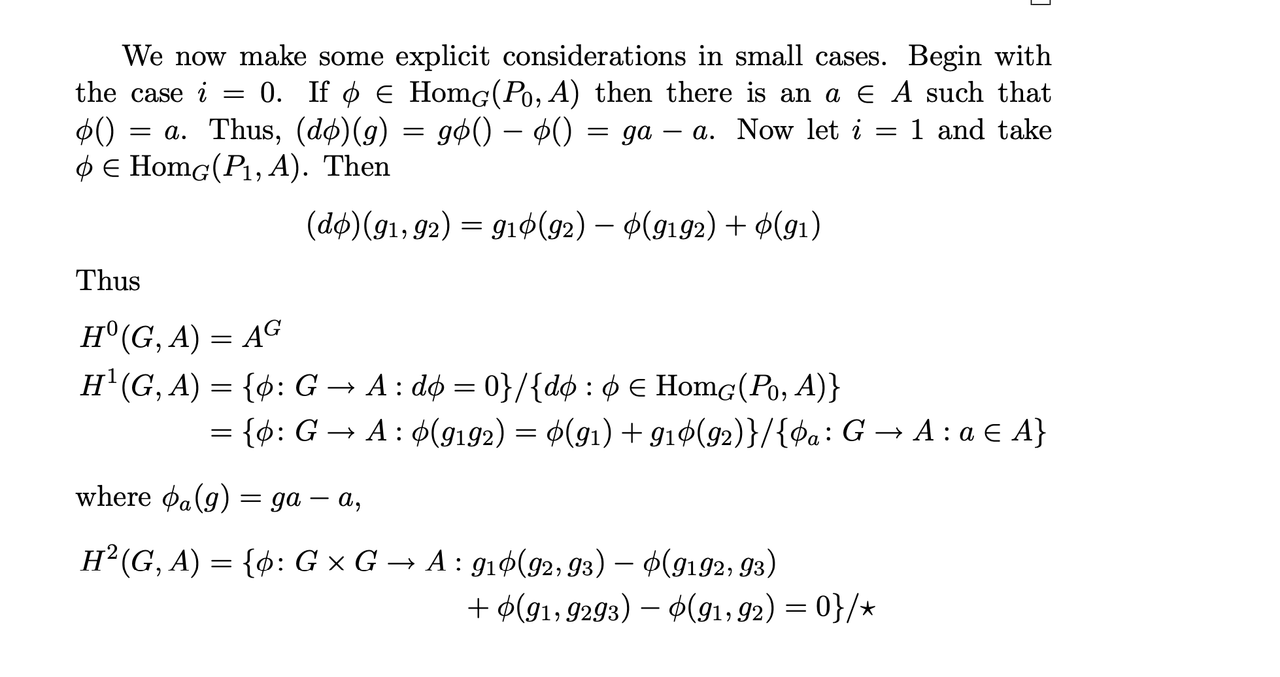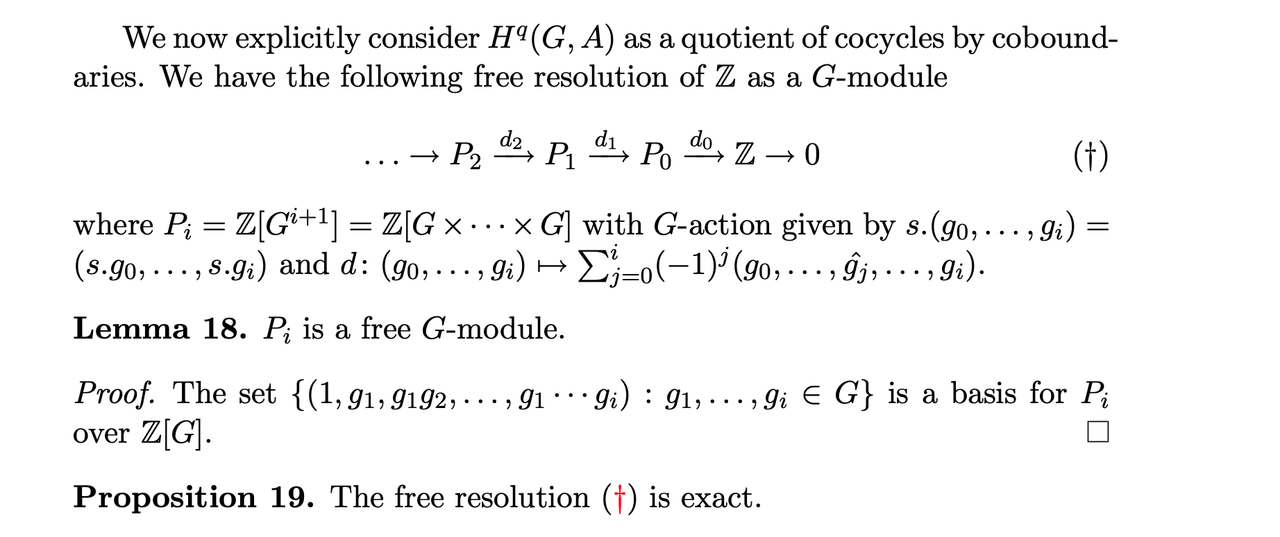Galois cohomology
-
TheMatrix楼主

- 论坛元老

2024年度优秀版主
TheMatrix 的博客 - 帖子互动: 295
- 帖子: 13935
- 注册时间: 2022年 7月 26日 00:35
#2 Re: Galois cohomology
Galois cohomology就是Galois群上的cohomology。起因之一是class field tower problem:
Is there a number field with an infinite class field tower?
具体是啥?还没搞懂
#3 Re: Galois cohomology
Number Theory is the study of G = Gal(Q ̄ /Q), the group of automorphisms of the algebraic closure Q ̄, and the sets G naturally acts on. The following question, for example, is an open problem: is every finite group a quotient of G?
Galois cohomology involves studying the group G by applying homological algebra. This provides a natural way to classify objects, e.g. twists of a curve, and linearizes problems by defining new invariants, revealing previously hidden structure.
#4 Re: Galois cohomology
首先要理解Galois module的概念:
Galois module is a G-module, with G being the Galois group。
G-module就是group ring Z[G]上的模。比如Then the ring OL of algebraic integers of L can be considered as an OK[G]-module, and one can ask what its structure is.
然后研究G作用在Galois module上。这是Galois representation的基本问题。
-
TheMatrix楼主

- 论坛元老

2024年度优秀版主
TheMatrix 的博客 - 帖子互动: 295
- 帖子: 13935
- 注册时间: 2022年 7月 26日 00:35
#5 Re: Galois cohomology
FoxMe 写了: 2025年 10月 24日 11:00Galois cohomology就是Galois群上的cohomology。起因之一是class field tower problem:
Is there a number field with an infinite class field tower?
具体是啥?还没搞懂
我知道cohomology研究的是xx的obstruction,但是还没有建立具体的图像。
-
TheMatrix楼主

- 论坛元老

2024年度优秀版主
TheMatrix 的博客 - 帖子互动: 295
- 帖子: 13935
- 注册时间: 2022年 7月 26日 00:35
#6 Re: Galois cohomology
FoxMe 写了: 2025年 10月 25日 10:13首先要理解Galois module的概念:
Galois module is a G-module, with G being the Galois group。
G-module就是group ring Z[G]上的模。比如Then the ring OL of algebraic integers of L can be considered as an OK[G]-module, and one can ask what its structure is.
然后研究G作用在Galois module上。这是Galois representation的基本问题。
对。群表示,群作用,group algebra 模,这三个差不多是同一个意思。哦。在加上G-module,这四个差不多是同一个意思。
原因: 未提供修改原因
#7 Re: Galois cohomology
来看几个简单的例子。令G=Gal(L/K), A=L*.
H0(G, A) = AG = {a ∈ A : s.a = a for all s ∈ G} = K*. 这个trivial情况没啥意思,只是定义。有意思的是:
H1(G, A) = 0. 搞懂这个结果都不容易,首先要知道
We define H1(G, A) as 1-cocycles modulo an equivalence relation. Here, a 1-cocycle is a set-theoretic map G → A, s → as such that ast = as.s(at), and we say as ∼ bs if there exists an a ∈ A with bs = a−1.as.s(a) for all s ∈ G.
https://wstein.org/edu/2010/582e/lectur ... mology.pdf
首先要理解啥是cocycle, coboundary... 先得理解chain complex/cohomology:
https://en.wikipedia.org/wiki/Chain_complex#Definitions
Elements of ker(dn) are called n-cocycles, while elements of im(dn−1) are called n-coboundaries.
#8 Re: Galois cohomology
Brauer group of a field K
Br(K) = H2 (K, (Ksep)*) 理解为
Br(K) = H2 ( Gal(Ksep / K), (Ksep)*)
这是infinite extension,留待以后再看
-
TheMatrix楼主

- 论坛元老

2024年度优秀版主
TheMatrix 的博客 - 帖子互动: 295
- 帖子: 13935
- 注册时间: 2022年 7月 26日 00:35
#9 Re: Galois cohomology
FoxMe 写了: 2025年 10月 26日 11:01来看几个简单的例子。令G=Gal(L/K), A=L*.
H0(G, A) = AG = {a ∈ A : s.a = a for all s ∈ G} = K*. 这个trivial情况没啥意思,只是定义。有意思的是:
H1(G, A) = 0. 搞懂这个结果都不容易,首先要知道
We define H1(G, A) as 1-cocycles modulo an equivalence relation. Here, a 1-cocycle is a set-theoretic map G → A, s → as such that ast = as.s(at), and we say as ∼ bs if there exists an a ∈ A with bs = a−1.as.s(a) for all s ∈ G.
https://wstein.org/edu/2010/582e/lectur ... mology.pdf
首先要理解啥是cocycle, coboundary... 先得理解chain complex/cohomology:
https://en.wikipedia.org/wiki/Chain_complex#Definitions
Elements of ker(dn) are called n-cocycles, while elements of im(dn−1) are called n-coboundaries.
一般的group cohomology是很抽象的。和Galois group联系在一起的稍微具体一点。但也是很难的。有点抡不动的感觉。
#10 Re: Galois cohomology
基本看懂了。这里解释了,这里的加法相当于上面的乘法。但是下面这句话没看懂:
If φ ∈ HomG(P0,A) then there is an a∈A sucht hat φ() = a.
TheMatrix 写了: 2025年 10月 26日 12:27一般的group cohomology是很抽象的。和Galois group联系在一起的稍微具体一点。但也是很难的。有点抡不动的感觉。
这里的群具体化了,就是group ring。free resolution是什么意思?就是P0, P1, P2等等都是free module,但是一般而言Z那个位置不一定是free module,可以是一般的module M. 但是resolution怎么翻译?
cycle(圆圈), boundary(边界)等概念都是从拓扑中来的。
d这个映射也不明所以。
-
TheMatrix楼主

- 论坛元老

2024年度优秀版主
TheMatrix 的博客 - 帖子互动: 295
- 帖子: 13935
- 注册时间: 2022年 7月 26日 00:35
#12 Re: Galois cohomology
Z怎么作为G-module?或者是给定的一个G action?
resolution好像翻译为预解式。
FoxMe 写了: 2025年 10月 30日 11:16这里的群具体化了,就是group ring。free resolution是什么意思?就是P0, P1, P2等等都是free module,但是一般而言Z那个位置不一定是free module,可以是一般的module M. 但是resolution怎么翻译?
cycle(圆圈), boundary(边界)等概念都是从拓扑中来的。
d这个映射也不明所以。
#13 Re: Galois cohomology
Z是trivial G-module, 即g(a) = a, a∈Z.
HomG (Z,A)≅AG就是从定义来的:f(g⋅1)=g⋅f(1) becomes
f(1)=g⋅f(1), so a group homomorphism f:Z→A is determined by f(1)=a∈A.
a=g⋅a for all g.
a∈AG (the fixed points of G in A).
Hence,
HomG (Z,A)≅AG
-
TheMatrix楼主

- 论坛元老

2024年度优秀版主
TheMatrix 的博客 - 帖子互动: 295
- 帖子: 13935
- 注册时间: 2022年 7月 26日 00:35
#15 Re: Galois cohomology
FoxMe 写了: 2025年 10月 30日 18:38Z是trivial G-module, 即g(a) = a, a∈Z.
HomG (Z,A)≅AG就是从定义来的:f(g⋅1)=g⋅f(1) becomes
f(1)=g⋅f(1), so a group homomorphism f:Z→A is determined by f(1)=a∈A.a=g⋅a for all g.
a∈AG (the fixed points of G in A).Hence,
HomG (Z,A)≅AG
嗯。对。
-
TheMatrix楼主

- 论坛元老

2024年度优秀版主
TheMatrix 的博客 - 帖子互动: 295
- 帖子: 13935
- 注册时间: 2022年 7月 26日 00:35
#17 Re: Galois cohomology
做一下脑力游戏。doesn't lead me anywhere...
Z也可以看成是Z[e]=Z[G0]也就是只有一个元素生成的Z-module。
这样就和P0,P1...统一了:
P0=Z[G]=Z[G1]
P1=Z[GxG]=Z[G2]
P2=Z[GxGxG]=Z[G3]
...
然后
... --> P2 --> P1 --> P0 --> Z --> 0
就变成了:
... --> Z[G3] --> Z[G2] --> Z[G1] --> Z[G0]=Z --> 0
free G-module也就是free Z[G]-module,也就是free R-module with R=Z[G]。
free R-module有点像vector space一样有一组基,有固定的维度,就是基的个数。但是它不是over a field,而是over a ring R。。。而且任意r ∈ R乘都不等于0。对,这个叫free,无torsion。
原因: 未提供修改原因
-
TheMatrix楼主

- 论坛元老

2024年度优秀版主
TheMatrix 的博客 - 帖子互动: 295
- 帖子: 13935
- 注册时间: 2022年 7月 26日 00:35
#18 Re: Galois cohomology
resolution就是一个chain of homomorphism,要求exact,也就是前面的image在后面的kernel之中:Im(di+1) ⊆ Ker(di),也就是didi+1=0,助记为dd=0,或者d2=0.
resolution这个概念是怎么想到的我也不知道,我觉得有点玄妙。因为resolution不是唯一的,far from unique,看起来比较任意。
resolution可以看成是一个节点一个节点延申出来的,比如第一个节点,也就是端点Z是固定的,发展出前面的一个节点P0,要求第一个homomorphism,d0: P0 --> Z,是满射,也就是P0 --> Z --> 0。这样的P0有很多个,因为d0是可以设计的。你只要设计出一个满射就行了。
有了P0和d0,可以再往前发展P1和d1,仍然具有很大的任意性:只要满足d0d1=0就行了。
然后就这样往前发展上去,(P2,d2), (P3,d3),...,每一步都具有任意性,只要满足dd=0就行了。
但是,据说,有一个东西不具有任意性,就是
H1 = Ker(d0)/Im(d1)
H2 = Ker(d1)/Im(d2)
H3 = Ker(d2)/Im(d3)
……
也就是不管你怎么具有任意性的往前发展,其比值不变。这个不变的比值,“显然”,和G有关系。因为什么都可以变,什么都是任意的,Pi的发展具有任意性。(端点Z任意性少一点,最开始定下来的)。只有G,是最开始定下来的,每一步都参与,(对,往前发展Pi的时候,要求每一步Pi都是free G-module)。所以这个比值一定和G有关系。反应了G的性质。
这个比值,就叫G的cohomology.
原因: 未提供修改原因
#19 Re: Galois cohomology
上面的d就是干这个事的,每次都降维。
a resolution is an exact sequence of modules that is used to define invariants characterizing the structure of a specific module.
这个作用很厉害,不仅是G,还能刻画最终那个module M(上面的Z是特例)的性质。
Every R-module possesses a free left resolution. The proof idea is to define E0 to be the free R-module generated by the elements of M, and then E1 to be the free R-module generated by the elements of the kernel of the natural map E0 → M etc.
这个证明也很简单,可以说是显而易见的。
TheMatrix 写了: 2025年 10月 30日 21:42做一下脑力游戏。doesn't lead me anywhere...
Z也可以看成是Z[e]=Z[G0]也就是只有一个元素生成的Z-module。
这样就和P0,P1...统一了:
P0=Z[G]=Z[G1]
P1=Z[GxG]=Z[G2]
P2=Z[GxGxG]=Z[G3]
...然后
... --> P2 --> P1 --> P0 --> Z --> 0就变成了:
... --> Z[G3] --> Z[G2] --> Z[G1] --> Z[G0]=Z --> 0
free G-module也就是free Z[G]-module,也就是free R-module with R=Z[G]。
free R-module有点像vector space一样有一组基,有固定的维度,就是基的个数。但是它不是over a field,而是over a ring R。。。而且任意r ∈ R乘都不等于0。对,这个叫free,无torsion。
#20 Re: Galois cohomology
Hilbert's syzygy theorem states that, if M is a finitely generated module over a polynomial ring k[x_1,... ,x_n] in n indeterminates over a field k, then the nth syzygy module of M is always a free module.
也就是说,这样的M一定有n级free resolution。




